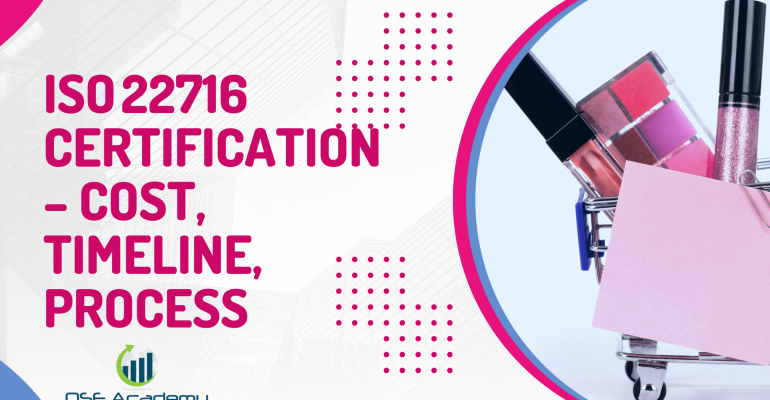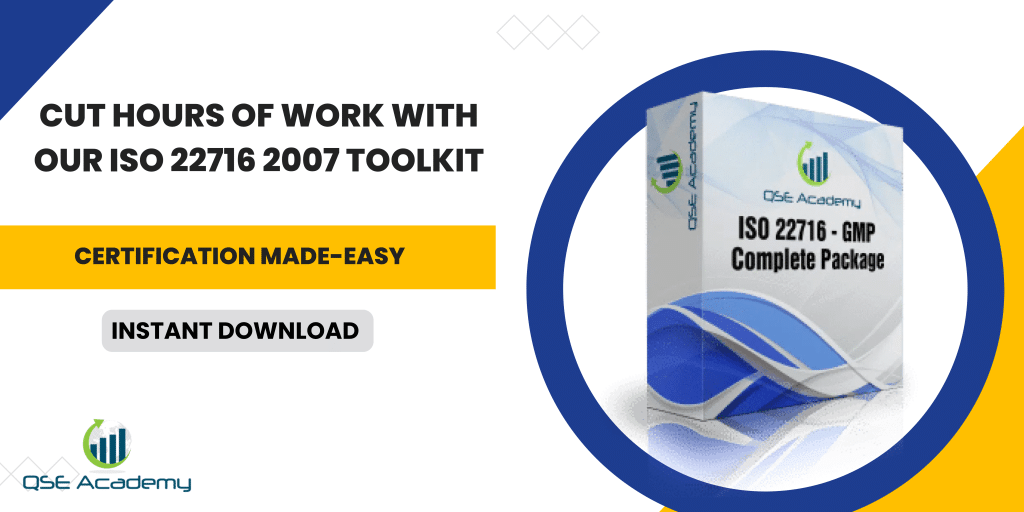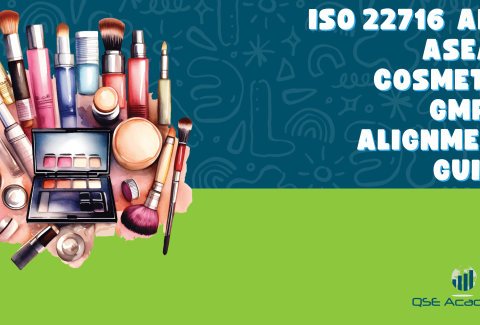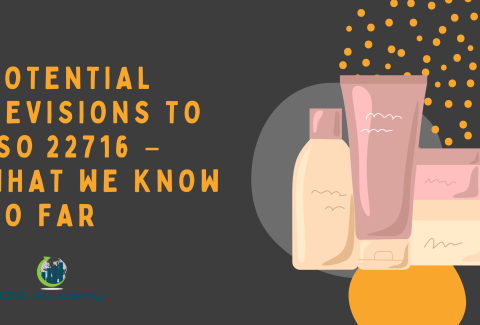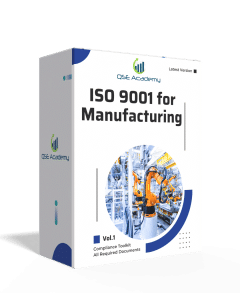ISO 22716 Certification – Cost, Timeline, Process
Last Updated on October 24, 2025 by Hafsa J.
The Complete Roadmap to ISO 22716 Certification
ISO 22716 certification can feel overwhelming at first — especially when you’re trying to understand the total investment of time, cost, and effort involved. Every cosmetic manufacturer wants to know three things before starting: How much will it cost? How long will it take? And what’s the exact process from start to finish?
This pillar guide gives you a complete, transparent overview of the ISO 22716 certification journey. You’ll see how certification bodies calculate costs, what a realistic project timeline looks like, and the practical steps every company must take to reach certification — and maintain it.
In my years helping cosmetic businesses implement ISO 22716, one thing has become clear: companies that plan properly from the start save weeks of effort and thousands in unnecessary expenses. This guide is designed to help you do exactly that — build your certification plan with clarity, confidence, and long-term value in mind.
Understanding ISO 22716 Certification at a Glance
Before diving into costs and timelines, it helps to understand what ISO 22716 certification really represents. It’s not just another compliance requirement — it’s a globally recognized Good Manufacturing Practice (GMP) standard specifically created for the cosmetics industry.
When a company achieves ISO 22716 certification, it means an independent accredited certification body has verified that its production, control, storage, and shipment processes meet internationally accepted GMP principles. In short, your business is operating under a documented system that prioritizes product safety, quality, and traceability.
For cosmetic manufacturers, private label brands, and contract packers, certification isn’t just about satisfying regulators — it’s also a strong commercial advantage. Retailers and distributors increasingly prefer suppliers who hold ISO 22716 certification because it signals professionalism and consistent quality.
Pro Tip: Think of ISO 22716 as a living management system, not a static checklist. It’s meant to evolve with your business — ensuring your products stay safe, compliant, and trusted as you grow.
ISO 22716 Certification Cost Breakdown
When planning for ISO 22716 certification, it’s important to look beyond the certificate itself — the process involves multiple cost components that vary depending on your company’s size, structure, and scope of operations.
The biggest factor is audit duration, which certification bodies calculate based on the number of employees, production lines, and process complexity. A single-site manufacturer with under 25 staff will typically require fewer audit days than a multi-site operation handling R&D, filling, and packaging.
Here’s a simple way to think about it:
- Small companies (1–25 employees): USD 3,000–6,000
- Medium companies (26–75 employees): USD 6,000–9,000
- Large or multi-site companies: USD 8,000–15,000 over a three-year certification cycle
You’ll also want to budget for supporting activities — internal audits, document development, and annual surveillance audits. These add up, but they’re crucial for maintaining compliance year after year.
Pro Tip: When requesting quotes from certification bodies, ask for a full three-year cost breakdown. It helps you plan for surveillance audits and avoid budget surprises later.
Common Pitfall: Many companies only account for the initial audit cost, forgetting that surveillance and re-certification audits are mandatory. Certification isn’t a one-time payment — it’s an ongoing investment in GMP consistency and credibility.
ISO 22716 Certification Timeline – 6 Steps to Completion
Now that we’ve covered the costs, let’s talk about how long certification actually takes — and what happens along the way. Most cosmetic manufacturers complete the process in 10 to 20 weeks, depending on their starting point and how organized their system is.
The timeline usually follows six clear phases:
- Gap Analysis & Project Planning (1–2 weeks)
This is your starting line — reviewing your current practices against ISO 22716 requirements to see what’s missing. - Documentation Development & Implementation (4–8 weeks)
You’ll draft and apply your GMP procedures, records, and work instructions. The better your documentation reflects real operations, the smoother your audit will be. - Training & Awareness (1–2 weeks)
Staff training ensures everyone understands their GMP responsibilities. Auditors will check for evidence of this later. - Internal Audit & Management Review (1–2 weeks)
Before inviting a certification body, perform an internal audit to verify readiness and hold a management review to confirm support and resources. - Certification Audit (2–4 weeks)
The external auditor conducts Stage 1 (document review) and Stage 2 (on-site verification). The scheduling and corrective actions can stretch this phase depending on availability and findings. - Corrective Actions & Certificate Issuance (2–6 weeks)
Once you address any non-conformities, the certification body finalizes your ISO 22716 certificate.
Pro Tip: Keep communication consistent across departments. Most delays happen because quality, production, and documentation teams work in silos instead of coordinating audit readiness together.
The ISO 22716 Certification Process Explained
Understanding the certification process helps you prepare for each phase with confidence. ISO 22716 certification isn’t just about passing an audit—it’s about proving your cosmetic manufacturing system consistently follows Good Manufacturing Practices from start to finish.
Here’s how the process typically unfolds:
1. Application & Quotation
You start by submitting key company details—scope of activities, number of employees, and locations—to your chosen certification body. They use this information to define your audit scope and provide a cost estimate.
2. Stage 1 Audit (Document Review)
Auditors review your documentation to verify that your GMP system is in place and aligned with ISO 22716 requirements. This stage often highlights missing or unclear procedures that need refinement before moving to Stage 2.
3. Stage 2 Audit (On-Site Verification)
Auditors visit your facility to assess how your documented processes are implemented. They’ll observe production areas, hygiene practices, equipment cleaning, and record-keeping.
4. Corrective Action Period
If non-conformities are found, you’ll need to submit corrective actions with supporting evidence. Quick, clear responses help accelerate certification.
5. Certificate Issuance
Once the certification body verifies that all requirements are met, your ISO 22716 certificate is issued—valid for three years.
6. Surveillance Audits
To maintain certification, expect annual surveillance audits focusing on implementation consistency, staff training, and continuous improvement.
Pro Tip: Keep all updated SOPs, training records, and CAPA logs in one shared “audit-ready” folder. It makes both initial and surveillance audits faster and less stressful.
Common Pitfall: Treating Stage 1 as a formality. Many companies rush it, only to face major findings later. Addressing documentation gaps early saves significant time during Stage 2.
Choosing the Right ISO 22716 Certification Body
Selecting the right certification body is one of the most important strategic decisions in your ISO 22716 journey. The certification body isn’t just the organization that audits you—it’s the one that validates your GMP compliance to the world.
Start by focusing on accredited certification bodies. Accreditation ensures your certifier has been independently evaluated for competence and impartiality. Bodies recognized by authorities such as UKAS, ANAB, or JAS-ANZ follow globally accepted audit standards under the International Accreditation Forum (IAF) network. This means your certificate will hold international credibility.
Beyond accreditation, look for experience in the cosmetics industry. Auditors who understand formulation, filling, labeling, and hygiene practices provide more relevant insights and smoother audits. Ask about their past cosmetic clients and audit approach before committing.
Pro Tip: Always verify a certification body’s accreditation directly on the accreditor’s official website. A legitimate certification body will be listed there with a defined scope that includes ISO 22716 or Cosmetic GMP.
Common Pitfall: Choosing based solely on price or convenience. Non-accredited certifiers may offer fast or cheap audits, but their certificates often fail to gain acceptance in export markets or regulatory submissions.
Real Example: A skincare brand once selected a non-accredited certifier to save money. When presenting their certificate to an overseas retailer, it was rejected as invalid. They had to start over with an accredited certification body—delaying their launch by months. One smart decision early on could have saved them time, money, and reputation.
Maintaining ISO 22716 Certification – Surveillance Audits
Achieving certification is just the beginning. To keep your ISO 22716 status valid, your company must undergo annual surveillance audits throughout the three-year certification cycle. These audits verify that your Good Manufacturing Practices are still effectively implemented and continuously improved.
Surveillance audits are usually shorter and more focused than your initial certification audit. Instead of reviewing your entire system, auditors select specific processes, departments, or records to check whether daily operations still align with your documented procedures.
Common focus areas include:
- Consistency in applying hygiene and cleaning procedures.
- Traceability of raw materials and finished goods.
- Equipment maintenance and calibration records.
- Training and competency of new staff.
- Corrective actions from previous audits.
Pro Tip: Keep ISO 22716 compliance active all year. Don’t wait for the audit notice—schedule internal reviews every quarter so your system stays sharp and audit-ready.
Common Pitfall: Many companies relax after certification and postpone updating documents or training. By the time the surveillance audit arrives, they scramble to fix issues that should’ve been managed continuously.
Staying consistent makes surveillance audits far less stressful—and shows auditors that ISO 22716 isn’t just a certificate for you, but a working part of your business culture.
How to Budget and Plan for Long-Term Compliance
Once you’re certified, the work doesn’t stop — maintaining ISO 22716 means planning for ongoing audits, updates, and system upkeep. A clear long-term budget ensures your certification remains active without last-minute surprises.
Start by mapping out a three-year certification cycle. This should include:
- Initial certification audit (Stage 1 and 2).
- Two annual surveillance audits — these confirm ongoing GMP compliance.
- Recertification audit at the end of year three.
Add to this your internal costs — training, internal audits, documentation reviews, and corrective actions. These are just as important as the certification fees because they keep your system alive and functional.
Pro Tip: Combine ISO 22716 with other management systems like ISO 9001 or ISO 14001 if they apply to your business. Integrated audits often reduce total man-days and long-term costs while improving overall efficiency.
Common Pitfall: Budgeting only for the initial certification and forgetting about maintenance. Without proper planning, companies sometimes postpone surveillance audits or staff training — both of which can put their certificate at risk.
When you treat ISO 22716 as a recurring operational investment, not a one-time project, it becomes a reliable foundation for product safety, brand trust, and regulatory compliance.
FAQs: ISO 22716 Certification Cost, Timeline & Process
How much does ISO 22716 certification cost on average?
Costs vary depending on your company’s size, structure, and certification body. Most small to mid-sized cosmetic manufacturers spend between USD 3,000 and 10,000 over the three-year certification cycle. Larger or multi-site operations can expect a higher investment, especially if multiple audits or international recognition are involved.
How long does ISO 22716 certification take?
On average, certification takes three to five months from planning to certificate issuance. The timeline depends on your documentation readiness, staff availability, and how quickly you address any audit findings.
What’s the difference between certification and accreditation?
Certification means your company has been independently verified to meet ISO 22716 requirements. Accreditation refers to the authorization that allows a certification body to issue valid ISO certificates. In short — accreditation ensures your certifier is credible, and certification proves that you are compliant.
How often are surveillance audits required?
Most certification bodies conduct annual surveillance audits for two years following the initial certification, then a full recertification audit in year three. These follow-up visits confirm your GMP system is still effective and properly maintained.
Can I combine ISO 22716 with other ISO certifications?
Yes. Many companies integrate ISO 22716 with ISO 9001 (Quality Management) or ISO 14001 (Environmental Management) to streamline audits and reduce overall costs.
Turn ISO 22716 Certification into a Long-Term Asset
ISO 22716 certification isn’t just about passing an audit — it’s about building trust, improving control, and demonstrating professionalism in cosmetic manufacturing.
By understanding the costs, timeline, and process, you can approach certification strategically, avoiding last-minute stress and unnecessary expenses. The key is choosing an accredited certification body, maintaining documentation consistently, and viewing GMP as a long-term investment in quality and safety.
When implemented properly, ISO 22716 becomes more than compliance — it becomes a foundation for market credibility and business growth.
If you’re ready to start planning your certification journey, you can download the ISO 22716 Certification Planning Toolkit or book a consultation to map your timeline, cost, and next steps with expert guidance.
Whether it’s ISO 9001, ISO 22000, or the cosmetics-focused ISO 22716, I’ve spent my career I’m not here to call myself an expert—I prefer “enthusiast” because I truly love what I do. When I’m not writing about standards, you’ll probably find me playing Piano 🎹, connecting with people, or diving into my next big project💫. I’m an engineer specialized in the food and agricultural industry
make ISO standards less intimidating and more approachable for everyone.
turning complex jargon into clear, actionable steps that businesses can actually use.
There’s something incredibly rewarding about helping people navigate food safety and quality management systems
in a way that feels simple, practical, and even enjoyable.
I have a Master’s in QHSE management and over 12 years of experience as a Quality Manager
I’ve helped more than 15 companies implement ISO 9001, ISO 22000, ISO 22716, GMP, and other standards
My clients include food producers, cosmetics manufacturers, laboratories, and service companies
I believe quality systems should be simple, useful, and efficient.

